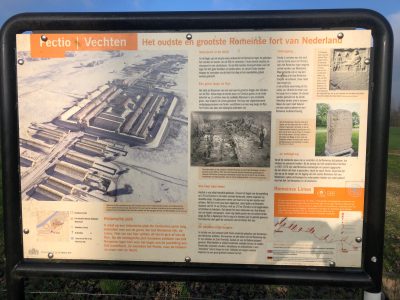The oldest and largest Roman fortress in the Netherlands.
Historic Place
You are on a historic site that was part of the border of the Roman Empire for hundreds of years, the Limes. Not far from here, the Vecht split off from the Rhine. Shortly before the beginning of the common era, the soldiers of the Roman army built a fortress (castellum) on this strategic split. They called it Fectio, after the native name for the Vecht.
Focal point in the battle
At the beginning of the first century, the Roman army tried to conquer the areas north and east to the Rhine. Fectio served as a support point and as a base of operations. The transport fleets of the army could easily reach and supply the fortress via the Rhine, and from Fectio troops and supplies could be brought deep into the enemy territory via the Vecht.
A border along the Rhine
The Romans failed to gain a foothold north of the Rhine. In the middle of the first century AD they finally gave up the fight. They then established the southern bank of the Rhine as a fortified frontier, called the Limes by historians. It was a balanced defense system of fortresses, watchtowers and a road along the Rhine. Fort Fectio was an important part of that.
From wood to stone
The fort has gone through many stages. Between the beginning of the era and 170 AD it was rebuilt at least six times, always in approximately the same place. The buildings were made of wood and surrounded by an earth wall. The fortress burned down a few times, such as during the Batavian Revolt of 69-70 AD. Shortly after 170 AD, it was rebuilt with tuff and brick. Although the stone fortress was a lot smaller than its wooden predecessors, it was still larger than the other forts along the Rhine in the Netherlands. From this moment on, it was used for another hundred years. A concrete plinth defines the contours of the stone fortress.
The soldiers and the citizens
In the course of its existence, Fectio has housed tens of thousands of Roman soldiers from all parts of the Roman Empire. Soldiers from the south of France, Spain and the Balkans have been stationed there. There were always several hundred soldiers living in the ramparts. Outside, women, merchants and craftsmen lived in a ‘camp village' (Vicus) along the river. Soldiers and civilians were buried in a large cemetery surrounding the fortress.
Demise…
Fectio was abandoned at the end of the third century AD, when the Roman army withdrew from the west of the Netherlands. Roman troops appeared occasionally for another century, but never for long. In the eighth century, the bishop of Utrecht took over the remains of the old fortress. The stones were used to build the first Utrecht churches. Only the name remained known from an old map and a Roman route description.
… and discovery
From the sixteenth century onwards, discoveries from the Roman period were made, which immediately drew historical attention. During the construction of the waterline fortress Vechten in 1867-1870, many Roman objects and traces were excavated. The name Fectio was written on an altar that was found at that time. Since these discoveries, awareness has been raised into the location of the oldest Roman fort in the Netherlands. Subsequent archaeological investigations have taught us more about the fort, the camp village and its inhabitants.
Roman Limes
The frontier of the Roman Empire, the Limes, is the largest archaeological […]

